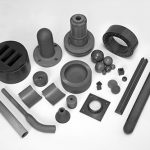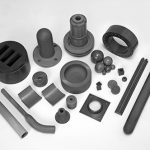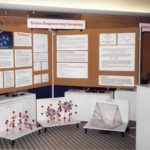Sialons are at the forefront of technical ceramic capabilities and applications, partly due to their relative novelty. First formed in the 1980s, sialon ceramics are now a well-established innovation. Intensive research and development into formulation optimisation, better forming methods, and higher-performance applications has fostered an in-depth understanding of this complex family of materials. However, the excitement surrounding sialon materials is largely due to their versatility; there are three usable phases of sialon ceramics, each exhibiting advantageous properties.
Beta-sialon, or β-sialon, is structurally analogous to β-silicon nitride and subsequently exhibits similar high-temperature strength and hardness. In future posts, we will discuss the other functional phases of sialons, but this article will explore the unique microstructural characteristics of the beta phase and what makes it so unique.
Exploring the Microstructure of Beta-Sialon
Beta-sialon is a ceramic material with the general formula Si6-zAlzOzN8-z, where z varies between 0-4.2 and requires a sintering additive such as yttria (Y2O3), ytterbia (Yb2O3) or magnesia (MgO). It’s part of the Si-Al-O-N family, which is derived from the combination of silicon nitride (Si3N4) and alumina (Al2O3). At the microstructural level, the ceramic consists of elongated beta-sialon grains interspersed with a primarily silicon-aluminium-oxynitride-based glassy phase. This combination yields a material with excellent high-temperature strength, hardness, and resistance to wear, corrosion, and thermal shock.
Beta-sialon’s composition allows it to maintain its mechanical properties at elevated temperatures, making it suitable for various high-temperature applications. Additionally, the presence of aluminum oxide in the sialon material does not hinder the resistance to oxidation and corrosion, further expanding its potential applications compared with silicon nitride.

Micrograph showing the microstructure of Syalon 101. The fine beta-sialon (β) grains surround small pockets of glass (g). Image Credit: International Syalons (Newcastle) Ltd.
What are Beta-Sialons Used For?
Sialons are a triumph of materials science, resulting from concerted efforts to derive a cost-effective alternative to silicon nitride. As far as performance properties are concerned, sialons have largely achieved parity with traditional silicon nitrides. What sets them apart is their sheer cost-effectiveness. It is much easier to densify sialons and fabricate finished parts than with silicon nitride. Hence production is cheaper and faster with little or no compromise on thermomechanical properties.
As such, beta-sialon has found a wide range of applications, including:
- Molten Metal Handling: Beta-sialon’s resistance to thermal shock and corrosion makes it an excellent choice for handling molten metals. It is commonly used in thermocouple protection sheaths, riser tubes, and other components that come into contact with molten metal.
- Welding and Cutting Applications: The high-temperature strength and hardness of beta-sialon make it suitable for use in welding and cutting tools, such as welding nozzles and cutting blades.
- Bushes and faceplates: Beta-sialon’s resistance to wear and low friction coefficient make it an ideal material for bushes and faceplates in high-temperature and/or abrasive environments.

Beta-Sialon components. Image Credit: International Syalons (Newcastle) Ltd.
Interested in Sialon Products?
As a leading company in the field of technical ceramics, International Syalons has extensive expertise in the world of sialon. Our commitment to innovation and excellence ensures that we stay at the forefront of materials science, offering our clients high-quality sialon ceramic products tailored to their needs. If you are interested in learning more about beta-sialon or other sialon composites, please do not hesitate to reach out to us. Together, we can find the best solution for your unique application requirements.



